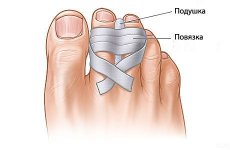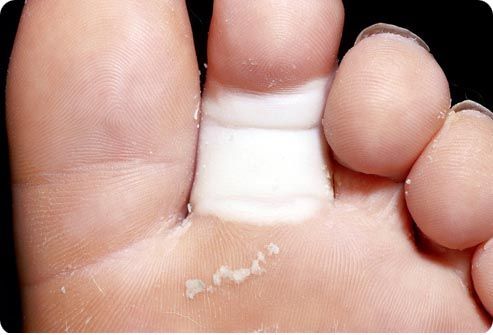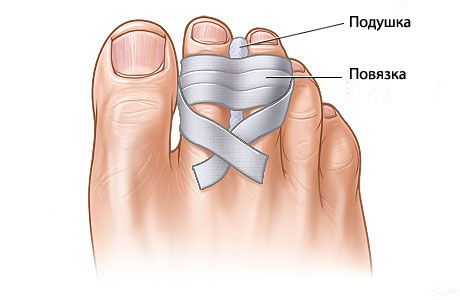Medical expert of the article
New publications
What to do for toe fractures?
Last reviewed: 04.07.2025

All iLive content is medically reviewed or fact checked to ensure as much factual accuracy as possible.
We have strict sourcing guidelines and only link to reputable media sites, academic research institutions and, whenever possible, medically peer reviewed studies. Note that the numbers in parentheses ([1], [2], etc.) are clickable links to these studies.
If you feel that any of our content is inaccurate, out-of-date, or otherwise questionable, please select it and press Ctrl + Enter.

When toes are broken, the affected area may not heal for a long time. And if not treated properly, the toe may lose its shape and flexibility. What are the causes, symptoms of a broken toe, and what to do about it?

Causes of a Broken Toe
Trauma or injury to the feet (trapped toe) or from a heavy object falling on the toes can result in broken toes. The position of the toes (at the front of the foot) makes them the most vulnerable part of the foot to fractures and injuries.
Long-term repetitive motion, such as in some sports activities, can lead to a broken finger, which may be called stress fracture or microfracture at the fracture site.
What are the symptoms of a broken toe?
The symptoms of a broken toe are as follows: pain, swelling, stiffness will most likely occur with a broken toe after an injury; it may be difficult to walk due to the pain, especially with a broken big toe. This is because the big toe bears most of the body's weight when walking or turning. A broken little toe can be very painful, but usually does not limit a person's ability to walk.
Other symptoms of a broken toe include bruising of the skin around the toes and bent or deformed toes.
Other problems can also develop as a result of a broken toe. Complications can occur immediately after the injury (from a few minutes to 5-6 days), or they can develop much later (from a couple of weeks to several years).
What are the possible complications of broken toes?
Nail injuries. Blood from these injuries can collect under the nails and is called a subungual hematoma. If the hematoma spot is large, the blood may need to be drained from under the nail. To drain a subungual hematoma, your doctor will make a small hole in the nail to allow the blood to drain. If the hematoma is very large and painful, the entire toenail may need to be removed. The injury may also result in broken nails, which may need to be removed.
Fracture. Rarely, broken leg bones may stick out through the skin after a fracture. This is called an open fracture. In this case, emergency medical attention and surgery may be needed.
Arthritis. After a fracture of the toes, which has already been cured, the legs may still hurt due to rheumatoid arthritis, which affects the toes. A person experiences pain in the legs, stiffness of movement, the toes may be deformed.
Incorrect tissue fusion after a fracture. Sometimes a bone fracture does not heal completely (so-called malunion) or the treatment is incorrect (so-called malunion of tissue after injury). Surgery is often needed to solve this problem. For example, osteotomy - eliminates bone and joint deformities.
Diagnosis of a broken toe
It is best to get a medical examination as soon as the first symptoms of a broken toe appear to ensure proper treatment.
The doctor will ask questions to determine exactly how the finger was injured and may need to check for other injuries.
Your doctor may recommend an X-ray to determine if your toe is broken. X-rays are not always necessary to diagnose broken toes, especially if there is clear damage to one of the smaller toes.
Stress fractures due to overuse or repetitive motion may require an MRI to make a diagnosis.
 [ 3 ]
[ 3 ]
When should you see a doctor about broken toes?
You should go to the emergency room if you have the following symptoms of a broken toe:
- Any signs of a possible open fracture, which include open wounds, bleeding, or drainage near the broken leg
- Coldness, numbness, tingling, or unusual sensations in your toes;
- Blue or gray color of the skin around the injury.
- Typical crunching (crepitation) when squeezing the affected area
Call your doctor if you have any of the following:
- If the broken finger gets worse or new pain does not go away with painkillers
- Wounds, redness or open sores on the affected legs
- The ankle or shin is injured or broken.
What is the treatment for a broken toe?
Caring for a Broken Toe at Home: You can treat a broken toe at home (as long as you don't need to see a doctor or go to the emergency room for treatment). You can do the following to help reduce pain and swelling after a broken toe and help the fracture heal faster.
Rest. Avoid strenuous exercise, standing, or walking for long periods. Crutches may be necessary, or you may need to wear a walking shoe to avoid straining your foot or putting extra weight on the fracture site while it heals.
Ice packs. Place ice in a plastic bag and apply it to the injury for 15-20 minutes every 1-2 hours for the first 1-2 days. Place a towel between your body and the ice to protect your skin. Frozen peas or corn can also be used to ice a broken leg. Peas or corn can help relieve swelling and redness at the site of the fracture even better than ice.
Elevation. To reduce swelling and pain in a broken toe, keep your legs elevated above heart level for as long as possible. Support your leg as firmly as possible (using several pillows, for example), especially when sleeping. Lying in a lounge chair is also helpful.
Treatment Prospects for Broken Toes
Depending on the location and severity of the toe fracture, the bones at the fracture site may need to be reset. If the victim has an open wound on the foot, a tetanus shot and antibiotic treatment may be necessary.
If there are open fractures of the leg, in some cases surgery and antibiotic treatment may be necessary. This type of fracture should be clearly visible to the doctor.
Medicines
Usually, acetaminophen (Tylenol) or ibuprofen (Motrin) may be needed to relieve pain. For a severe fracture, your doctor may prescribe a pain reliever that is much stronger than the previous one.
If the toe at the fracture site is displaced (the two ends of the broken leg bone do not meet) or rotated (the toe points in the wrong direction), your doctor may need to reduce it or set the broken toe back into place.
Sometimes local anesthesia may be needed to numb the feet or toes before the bones are put back into place.
Once the pain has subsided, splints will be applied to the toes of the broken foot to hold them in place while they heal.
Plaster tape
If there is a minor or small crack in the bone of one of the little toes, the doctor may require a plaster cast on the injured foot to support it. This procedure is called plaster casting.
The tape will not generally make your foot safe for swimming, so you will need to remove it before you go swimming, so consult your doctor first.
How to work with plaster tape
Place a small piece of cotton wool or gauze between the fingers that meet. This prevents the skin between the fingers from developing sores or blisters. Use a small amount of tape as needed to hold the broken finger and the finger next to it in place. If the fingers are too deformed, this can cause additional swelling and pain. Surgery
It is usually not needed for a simple toe fracture. Shoes with a hard sole should be worn; they are durable and will support the foot. The doctor may recommend special shoes for the patient if the feet or toes are very swollen.
Surgery may be needed if the big toe is broken and the fracture involves several small leg fractures, if a bone in the leg or the leg itself is broken.
What are the outlooks for recovery of broken toes?

Contact your doctor to make sure you continue to receive proper treatment. Call your doctor or emergency room if any problems or complications arise before your doctor's appointment.
Broken fingers usually take about six weeks to heal. If the problem lasts longer than six weeks, more x-rays may be needed.
The injury should be rechecked by a doctor to assess how the bone is healing.
Simple leg fractures usually heal without problems. However, a serious fracture or joint fracture is sometimes associated with the risk of arthritis, pain, stiffness, and possibly even disability. Therefore, if you have symptoms of a broken toe or leg, you should see a doctor immediately.

